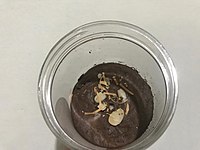
Dessert is a course that concludes a meal. The course consists of sweet foods, such as cake, biscuit, ice cream and possibly a beverage such as dessert wine and liqueur. Some cultures sweeten foods that are more commonly savory to create desserts. In some parts of the world there is no tradition of a dessert course to conclude a meal.

Turkish cuisine is largely the heritage of Ottoman cuisine, Seljuk cuisine and the Turkish diaspora. Turkish cuisine with traditional Turkic elements such as yogurt, ayran, kaymak, exerts and gains influences to and from Mediterranean, Balkan, Middle Eastern, Central Asian and Eastern European cuisines.

A macaroon is a small cake or cookie, originally made from ground almonds, egg whites, and sugar, but now often with coconut or other nuts. They may also include jam, chocolate, or other flavorings.

Dutch cuisine is formed from the cooking traditions and practices of the Netherlands. The country's cuisine is shaped by its location on the fertile Rhine–Meuse–Scheldt delta at the North Sea, giving rise to fishing, farming, and overseas trade. Due to the availability of water and flat grassland, the Dutch diet contains many dairy products such as butter and cheese. The court of the Burgundian Netherlands enriched the cuisine of the elite in the Low Countries in the 15th and 16th century, so did in the 17th and 18th century colonial trade, when the Dutch ruled the spice trade, played a pivotal role in the global spread of coffee, and started the modern era of chocolate, by developing the Dutch process chocolate.
Amaretto is an almond-flavored Italian liqueur.

A macaron or French macaroon is a sweet meringue-based confection made with egg white, icing sugar, granulated sugar, almond meal, and often food colouring.

Rosettes are thin, cookie-like fritters made with iron molds that are found in many cultures. They are crispy and characterized by their lacy pattern.

Pinolate or pignolate are a type of cookie originating in Neapolitan, Genovese and Umbrian cuisine. They are popular in all of southern Italy, and in Sicilian communities in the United States.

Acıbadem kurabiyesi is a traditional Turkish biscuit made of almonds, sugar and egg whites. The traditional recipes include a small amount of bitter almonds, which gives this cookie its name. However, because bitter almonds are not readily available, almond extract is typically used as a substitute. These biscuits are part of the stock-in trade of almost every bakery in Turkey and are seldom made at home.

Amaretti di Saronno are a type of amaretto, a bitter-sweet flavored macaroon, traditional to the Italian city of Saronno. It is one of many types of traditional amaretti, but the only one made with apricot kernels.

Sponge cake is a light cake made with eggs, flour and sugar, sometimes leavened with baking powder. Some sponge cakes do not contain egg yolks, like angel food cake, but most of them do. Sponge cakes, leavened with beaten eggs, originated during the Renaissance, possibly in Spain. The sponge cake is thought to be one of the first non-yeasted cakes, and the earliest attested sponge cake recipe in English is found in a book by the British poet Gervase Markham, The English Huswife, Containing the Inward and Outward Virtues Which Ought to Be in a Complete Woman (1615). Still, the cake was much more like a cracker: thin and crispy. Sponge cakes became the cake recognised today when bakers started using beaten eggs as a rising agent in the mid-18th century. The Victorian creation of baking powder by British food manufacturer Alfred Bird in 1843 allowed the addition of butter to the traditional sponge recipe, resulting in the creation of the Victoria sponge. Cakes are available in many flavours and have many recipes as well. Sponge cakes have become snack cakes via the Twinkie.

Brutti ma buoni, also known as mandorlati di San Clemente, is a type of hazelnut or almond-flavoured biscuit produced in Prato, Tuscany, and many other cities. These biscuits are made by incorporating meringue, which is an egg white and sugar mixture, with roasted chopped nuts. Brutti ma buoni are crunchy on the outside with a soft texture in the middle. Their origin is disputed, but they have been made since at least the mid-1800s.

Qurabiya also ghraybe, ghorayeba, ghoriba, ghribia, ghraïba, gurabija, ghriyyaba,, kurabiye, or kourabiedes and numerous other spellings and pronunciations, is a shortbread-type biscuit, usually made with ground almonds. Versions are found in most Arab, Balkan and Ottoman cuisines, with various different forms and recipes. They are similar to polvorones from Andalusia.

Flour kurabiye is a kind of Turkish cookie that is made from butter, sunflower oil, baking powder, and the namesake ingredient flour. Generally, vanilla powder is also added. Flour kurabiye is a variant of kurabiye.

Kavala Almond Cookies, Kavala Cookies or Edirne Almond Cookies (Turkish: Edirne Bademli Kurabiyesi) is a kurabiye from Turkish cuisine. The Kavala cookie is made with almond, flour and butter. The kurabiye gets its name from Kavala. The modern recipe of the cookie originated during the Ottoman Empire.
Muğla halkası, or Hıdırellez Halkası, is a kind of Turkish cookie that is made from, olive oil, baking powder, yogurt, egg, lemon juice and flour.


















